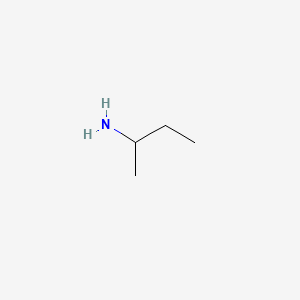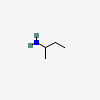Sec-butylamine
- SEC-BUTYLAMINE
- butan-2-amine
- 13952-84-6
- 2-Butanamine
- 2-Aminobutane
- Create:2005-03-26
- Modify:2025-01-11
 Butylamine (annotation moved to).
Butylamine (annotation moved to).
- SEC-BUTYLAMINE
- butan-2-amine
- 13952-84-6
- 2-Butanamine
- 2-Aminobutane
- 2-Butylamine
- 1-Methylpropylamine
- Tutane
- Butafume
- 1-Methylpropanamine
- Deccotane
- Frucote
- (RS)-sec-Butylamine
- 2-Aminobutane base
- s-butylamine
- Butylamine [ISO]
- Secondary butylamine
- (+/-)-2-Aminobutane
- 2-AB
- sec-butyl amine
- (+-)-sec-butylamine
- 33966-50-6
- sec-Butanamine
- (+/-)-sec-Butylamine
- NSC 8030
- DL-2-Butylamine
- (Rs)-2-aminobutane
- Propylamine, 1-methyl-
- MFCD00008094
- QAZ452YGSG
- sec-?Butylamine
- DTXSID4022284
- CHEBI:74526
- 2-Butanamine, hydrochloride
- NSC-8030
- Caswell No. 125
- Propylamine, 1-methyl
- sec.-butylamine
- DL-sec-Butylamine
- Mono-sec-butylamine
- sec-BUTYLAMINE, HYDROCHLORIDE
- 2-AB (VAN)
- CCRIS 4757
- HSDB 6312
- (+/-)-2-Butylamine
- EINECS 237-732-7
- UNII-QAZ452YGSG
- EPA Pesticide Chemical Code 004214
- sec butylamine
- sec-butylamin
- sec.butylamine
- sec- butylamine
- AI3-35093
- s-butyl amine
- Sec. Butylamine
- 2-amino-butane
- monosec.butylamine
- secondarybutylamine
- butane, 2-amino-
- methyl-1-propanamine
- racemic 2-butylamine
- 1-Methyl-Propylamine
- (-)-sec-Butylamine
- sec-Butylamine, 99%
- sec-C4H9NH2
- .+/-.-sec-Butylamine
- (rs)-1-methylpropylamine
- (.+/-.)-sec-Butylamine
- NCIOpen2_009269
- SEC-BUTYLAMINE [MI]
- SEC-BUTYLAMINE [FHFI]
- SEC-BUTYLAMINE [HSDB]
- DTXCID602284
- WLN: ZY2&1
- 2-Butanamine, (.+/-.)-
- CHEMBL3186956
- FEMA NO. 4240
- (+/-)-sec-Butylamine, 99%
- NSC8030
- sec-Butylamine, analytical standard
- STR00953
- SEC-BUTYLAMINE DL-FORM [MI]
- Tox21_301321
- STL194265
- AKOS000119064
- AKOS016352717
- NCGC00255387-01
- CAS-13952-84-6
- DB-062902
- ( inverted exclamation markA)-sec-Butylamine
- B0708
- NS00020057
- EN300-19017
- C18706
- A806444
- A828547
- Q288208
- J-007288
- F2190-0361
- Z104472234
- InChI=1/C4H11N/c1-3-4(2)5/h4H,3,5H2,1-2H
- 1-sec-Butylamine, salt with d-3-bromo-x-camphorsulfonic acid
44.0 99.99
18.0 14.80
58.0 12.50
41.0 10.10
30.0 8.40
44.0 99.99
41.0 10.06
58.0 9.15
45.0 8.38
42.0 6.86
44 999
18 148
58 125
41 101
30 84
44 999
41 101
58 92
45 84
42 69
 Butylamine (annotation moved to)
Butylamine (annotation moved to)- Cytoplasm
- Extracellular




H225 (100%): Highly Flammable liquid and vapor [Danger Flammable liquids]
H302 (100%): Harmful if swallowed [Warning Acute toxicity, oral]
H314 (100%): Causes severe skin burns and eye damage [Danger Skin corrosion/irritation]
H332 (100%): Harmful if inhaled [Warning Acute toxicity, inhalation]
H400 (100%): Very toxic to aquatic life [Warning Hazardous to the aquatic environment, acute hazard]
P210, P233, P240, P241, P242, P243, P260, P261, P264, P270, P271, P273, P280, P301+P317, P301+P330+P331, P302+P361+P354, P303+P361+P353, P304+P340, P305+P354+P338, P316, P317, P321, P330, P363, P370+P378, P391, P403+P235, P405, and P501
(The corresponding statement to each P-code can be found at the GHS Classification page.)
Aggregated GHS information provided per 39 reports by companies from 1 notifications to the ECHA C&L Inventory. Each notification may be associated with multiple companies.
Information may vary between notifications depending on impurities, additives, and other factors. The percentage value in parenthesis indicates the notified classification ratio from companies that provide hazard codes. Only hazard codes with percentage values above 10% are shown.
Flam. Liq. 2 (100%)
Acute Tox. 4 (100%)
Skin Corr. 1A (100%)
Acute Tox. 4 (100%)
Aquatic Acute 1 (100%)
Special Hazards of Combustion Products: Toxic oxides of nitrogen may be formed in fire.
Behavior in Fire: Vapor is heavier than air and may travel to a source of ignition and flash back. Containers may explode in fire. (USCG, 1999)
EYES: First check the victim for contact lenses and remove if present. Flush victim's eyes with water or normal saline solution for 20 to 30 minutes while simultaneously calling a hospital or poison control center. Do not put any ointments, oils, or medication in the victim's eyes without specific instructions from a physician. IMMEDIATELY transport the victim after flushing eyes to a hospital even if no symptoms (such as redness or irritation) develop.
SKIN: IMMEDIATELY flood affected skin with water while removing and isolating all contaminated clothing. Gently wash all affected skin areas thoroughly with soap and water. IMMEDIATELY call a hospital or poison control center even if no symptoms (such as redness or irritation) develop. IMMEDIATELY transport the victim to a hospital for treatment after washing the affected areas.
INHALATION: IMMEDIATELY leave the contaminated area; take deep breaths of fresh air. If symptoms (such as wheezing, coughing, shortness of breath, or burning in the mouth, throat, or chest) develop, call a physician and be prepared to transport the victim to a hospital. Provide proper respiratory protection to rescuers entering an unknown atmosphere. Whenever possible, Self-Contained Breathing Apparatus (SCBA) should be used; if not available, use a level of protection greater than or equal to that advised under Protective Clothing.
INGESTION: DO NOT INDUCE VOMITING. Corrosive chemicals will destroy the membranes of the mouth, throat, and esophagus and volatile chemicals have a high risk of being aspirated into the victim's lungs during vomiting. Thus, the risk of increasing the medical problems by inducing vomiting of a volatile corrosive chemical is very high. If the victim is conscious and not convulsing, give 1 or 2 glasses of water to dilute the chemical and IMMEDIATELY call a hospital or poison control center. IMMEDIATELY transport the victim to a hospital. If the victim is convulsing or unconscious, do not give anything by mouth, ensure that the victim's airway is open and lay the victim on his/her side with the head lower than the body. DO NOT INDUCE VOMITING. IMMEDIATELY transport the victim to a hospital. (NTP, 1992)
Fire Extinguishing Agents Not to Be Used: Water may be ineffective.
Fire Extinguishing Agents: "Alcohol" foam, dry chemical, carbon dioxide (USCG, 1999)
Excerpt from ERG Guide 153 [Substances - Toxic and/or Corrosive (Combustible)]:
IMMEDIATE PRECAUTIONARY MEASURE: Isolate spill or leak area in all directions for at least 50 meters (150 feet) for liquids and at least 25 meters (75 feet) for solids.
SPILL: Increase the immediate precautionary measure distance, in the downwind direction, as necessary.
FIRE: If tank, rail tank car or highway tank is involved in a fire, ISOLATE for 800 meters (1/2 mile) in all directions; also, consider initial evacuation for 800 meters (1/2 mile) in all directions. (ERG, 2024)
Patents are available for this chemical structure:
https://patentscope.wipo.int/search/en/result.jsf?inchikey=BHRZNVHARXXAHW-UHFFFAOYSA-N
- CAMEO ChemicalsLICENSECAMEO Chemicals and all other CAMEO products are available at no charge to those organizations and individuals (recipients) responsible for the safe handling of chemicals. However, some of the chemical data itself is subject to the copyright restrictions of the companies or organizations that provided the data.https://cameochemicals.noaa.gov/help/reference/terms_and_conditions.htm?d_f=falseSEC-BUTYLAMINEhttps://cameochemicals.noaa.gov/chemical/8359CAMEO Chemical Reactivity Classificationhttps://cameochemicals.noaa.gov/browse/react
- CAS Common ChemistryLICENSEThe data from CAS Common Chemistry is provided under a CC-BY-NC 4.0 license, unless otherwise stated.https://creativecommons.org/licenses/by-nc/4.0/(±)-sec-Butylaminehttps://commonchemistry.cas.org/detail?cas_rn=13952-84-6
- ChemIDplusChemIDplus Chemical Information Classificationhttps://pubchem.ncbi.nlm.nih.gov/source/ChemIDplus
- DTP/NCILICENSEUnless otherwise indicated, all text within NCI products is free of copyright and may be reused without our permission. Credit the National Cancer Institute as the source.https://www.cancer.gov/policies/copyright-reuse
- EPA DSSTox2-Butanaminehttps://comptox.epa.gov/dashboard/DTXSID4022284CompTox Chemicals Dashboard Chemical Listshttps://comptox.epa.gov/dashboard/chemical-lists/
- European Chemicals Agency (ECHA)LICENSEUse of the information, documents and data from the ECHA website is subject to the terms and conditions of this Legal Notice, and subject to other binding limitations provided for under applicable law, the information, documents and data made available on the ECHA website may be reproduced, distributed and/or used, totally or in part, for non-commercial purposes provided that ECHA is acknowledged as the source: "Source: European Chemicals Agency, http://echa.europa.eu/". Such acknowledgement must be included in each copy of the material. ECHA permits and encourages organisations and individuals to create links to the ECHA website under the following cumulative conditions: Links can only be made to webpages that provide a link to the Legal Notice page.https://echa.europa.eu/web/guest/legal-notice(+/-)-sec-Butylaminehttps://echa.europa.eu/substance-information/-/substanceinfo/100.209.631(+/-)-sec-Butylamine (EC: 684-161-8)https://echa.europa.eu/information-on-chemicals/cl-inventory-database/-/discli/details/214646
- FDA Global Substance Registration System (GSRS)LICENSEUnless otherwise noted, the contents of the FDA website (www.fda.gov), both text and graphics, are not copyrighted. They are in the public domain and may be republished, reprinted and otherwise used freely by anyone without the need to obtain permission from FDA. Credit to the U.S. Food and Drug Administration as the source is appreciated but not required.https://www.fda.gov/about-fda/about-website/website-policies#linking
- Human Metabolome Database (HMDB)LICENSEHMDB is offered to the public as a freely available resource. Use and re-distribution of the data, in whole or in part, for commercial purposes requires explicit permission of the authors and explicit acknowledgment of the source material (HMDB) and the original publication (see the HMDB citing page). We ask that users who download significant portions of the database cite the HMDB paper in any resulting publications.http://www.hmdb.ca/citingsec-Butylaminehttp://www.hmdb.ca/metabolites/HMDB0032179HMDB0032179_cms_26799https://hmdb.ca/metabolites/HMDB0032179#spectra
- ChEBI
- LOTUS - the natural products occurrence databaseLICENSEThe code for LOTUS is released under the GNU General Public License v3.0.https://lotus.nprod.net/Sec-butylaminehttps://www.wikidata.org/wiki/Q288208LOTUS Treehttps://lotus.naturalproducts.net/
- ChEMBLLICENSEAccess to the web interface of ChEMBL is made under the EBI's Terms of Use (http://www.ebi.ac.uk/Information/termsofuse.html). The ChEMBL data is made available on a Creative Commons Attribution-Share Alike 3.0 Unported License (http://creativecommons.org/licenses/by-sa/3.0/).http://www.ebi.ac.uk/Information/termsofuse.html
- EPA Chemical and Products Database (CPDat)EPA CPDat Classificationhttps://www.epa.gov/chemical-research/chemical-and-products-database-cpdat
- EPA Pesticide Ecotoxicity Database
- EU Pesticides Database2-Aminobutane (aka sec-butylamine)https://ec.europa.eu/food/plant/pesticides/eu-pesticides-database/start/screen/active-substances/details/828
- FDA Substances Added to FoodLICENSEUnless otherwise noted, the contents of the FDA website (www.fda.gov), both text and graphics, are not copyrighted. They are in the public domain and may be republished, reprinted and otherwise used freely by anyone without the need to obtain permission from FDA. Credit to the U.S. Food and Drug Administration as the source is appreciated but not required.https://www.fda.gov/about-fda/about-website/website-policies#linking
- MassBank of North America (MoNA)LICENSEThe content of the MoNA database is licensed under CC BY 4.0.https://mona.fiehnlab.ucdavis.edu/documentation/license
- NIST Mass Spectrometry Data CenterLICENSEData covered by the Standard Reference Data Act of 1968 as amended.https://www.nist.gov/srd/public-lawsec-Butylaminehttp://www.nist.gov/srd/nist1a.cfm
- SpectraBase2-BUTANAMINEhttps://spectrabase.com/spectrum/9RpTevNHVCT2-Butylaminehttps://spectrabase.com/spectrum/BGCXoAamww8sec-BUTYLAMINEhttps://spectrabase.com/spectrum/FQNsaiZB2Fpsec-butylaminehttps://spectrabase.com/spectrum/6B2VEvGW7Cysec-BUTYLAMINEhttps://spectrabase.com/spectrum/BuMsBNWo0XW(R)-(-)-sec-Butylaminehttps://spectrabase.com/spectrum/EF8FVBgyDXDsec-BUTYLAMINEhttps://spectrabase.com/spectrum/LHaqosyNW0m2-BUTANAMINEhttps://spectrabase.com/spectrum/4trSpul43jm2-BUTANAMINEhttps://spectrabase.com/spectrum/IyDWOMqBiCK2-BUTANAMINEhttps://spectrabase.com/spectrum/2ooMfvpzhGtsec-Butylaminehttps://spectrabase.com/spectrum/K5ykEEe1Pausec-Butylaminehttps://spectrabase.com/spectrum/CLuTP9EhyT0sec-Butylaminehttps://spectrabase.com/spectrum/3wEale0Drt12-Butanaminehttps://spectrabase.com/spectrum/ENQpP70HrTx2-Butanaminehttps://spectrabase.com/spectrum/EtNkfvAtqHQ
- IUPAC Digitized pKa Datasetbutane, 2-amino-https://github.com/IUPAC/Dissociation-Constants
- Japan Chemical Substance Dictionary (Nikkaji)
- Joint FAO/WHO Expert Committee on Food Additives (JECFA)LICENSEPermission from WHO is not required for the use of WHO materials issued under the Creative Commons Attribution-NonCommercial-ShareAlike 3.0 Intergovernmental Organization (CC BY-NC-SA 3.0 IGO) licence.https://www.who.int/about/policies/publishing/copyright
- KEGGLICENSEAcademic users may freely use the KEGG website. Non-academic use of KEGG generally requires a commercial licensehttps://www.kegg.jp/kegg/legal.html
- KNApSAcK Species-Metabolite Database
- MassBank Europe
- Metabolomics Workbench
- NMRShiftDB
- Springer Nature
- Thieme ChemistryLICENSEThe Thieme Chemistry contribution within PubChem is provided under a CC-BY-NC-ND 4.0 license, unless otherwise stated.https://creativecommons.org/licenses/by-nc-nd/4.0/
- Wikidatasec-butylaminehttps://www.wikidata.org/wiki/Q288208
- WikipediaSec-Butylaminehttps://en.wikipedia.org/wiki/Sec-Butylamine
- Wiley
- PubChem
- GHS Classification (UNECE)GHS Classification Treehttp://www.unece.org/trans/danger/publi/ghs/ghs_welcome_e.html
- NORMAN Suspect List ExchangeLICENSEData: CC-BY 4.0; Code (hosted by ECI, LCSB): Artistic-2.0https://creativecommons.org/licenses/by/4.0/NORMAN Suspect List Exchange Classificationhttps://www.norman-network.com/nds/SLE/
- EPA Substance Registry ServicesEPA SRS List Classificationhttps://sor.epa.gov/sor_internet/registry/substreg/LandingPage.do
- EPA Chemicals under the TSCAEPA TSCA Classificationhttps://www.epa.gov/tsca-inventory
- MolGenieMolGenie Organic Chemistry Ontologyhttps://github.com/MolGenie/ontology/
- PATENTSCOPE (WIPO)SID 403030777https://pubchem.ncbi.nlm.nih.gov/substance/403030777





